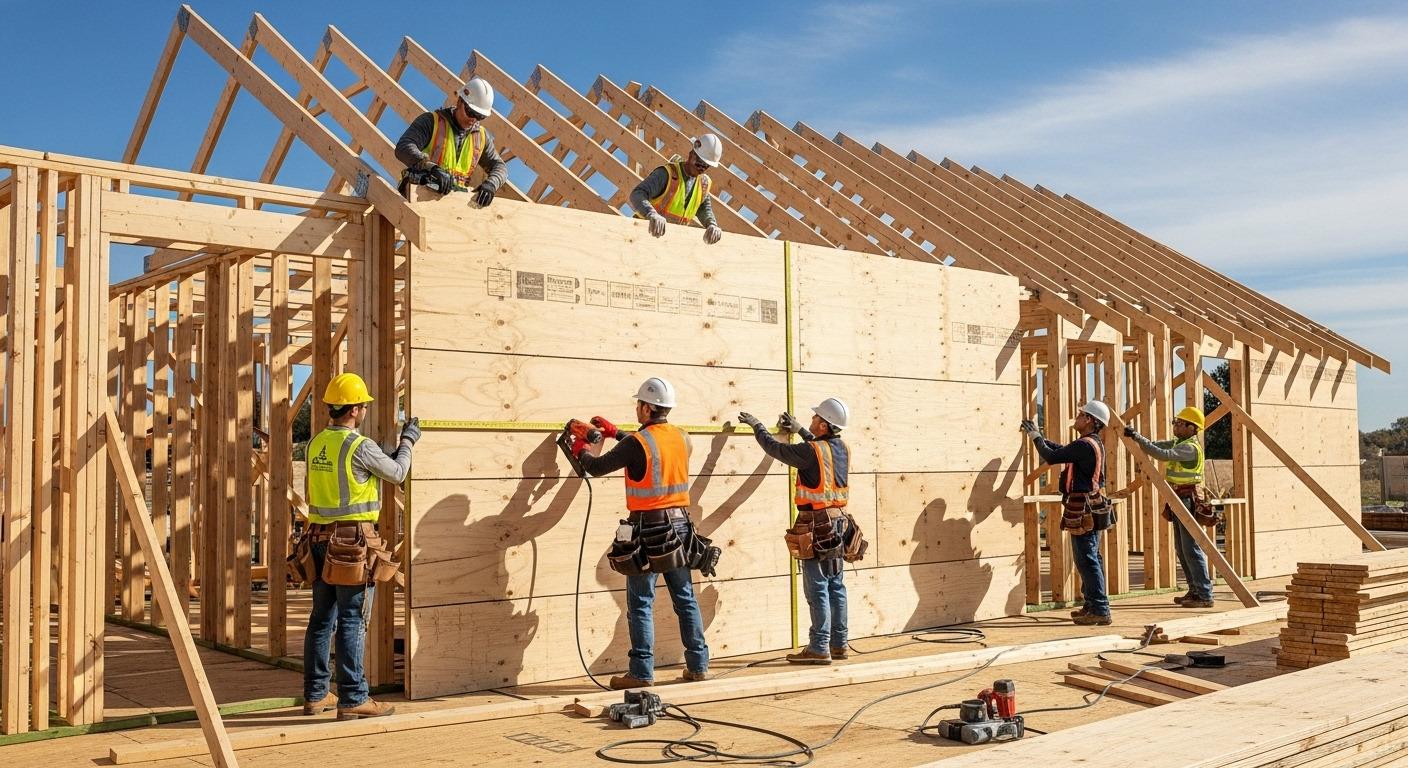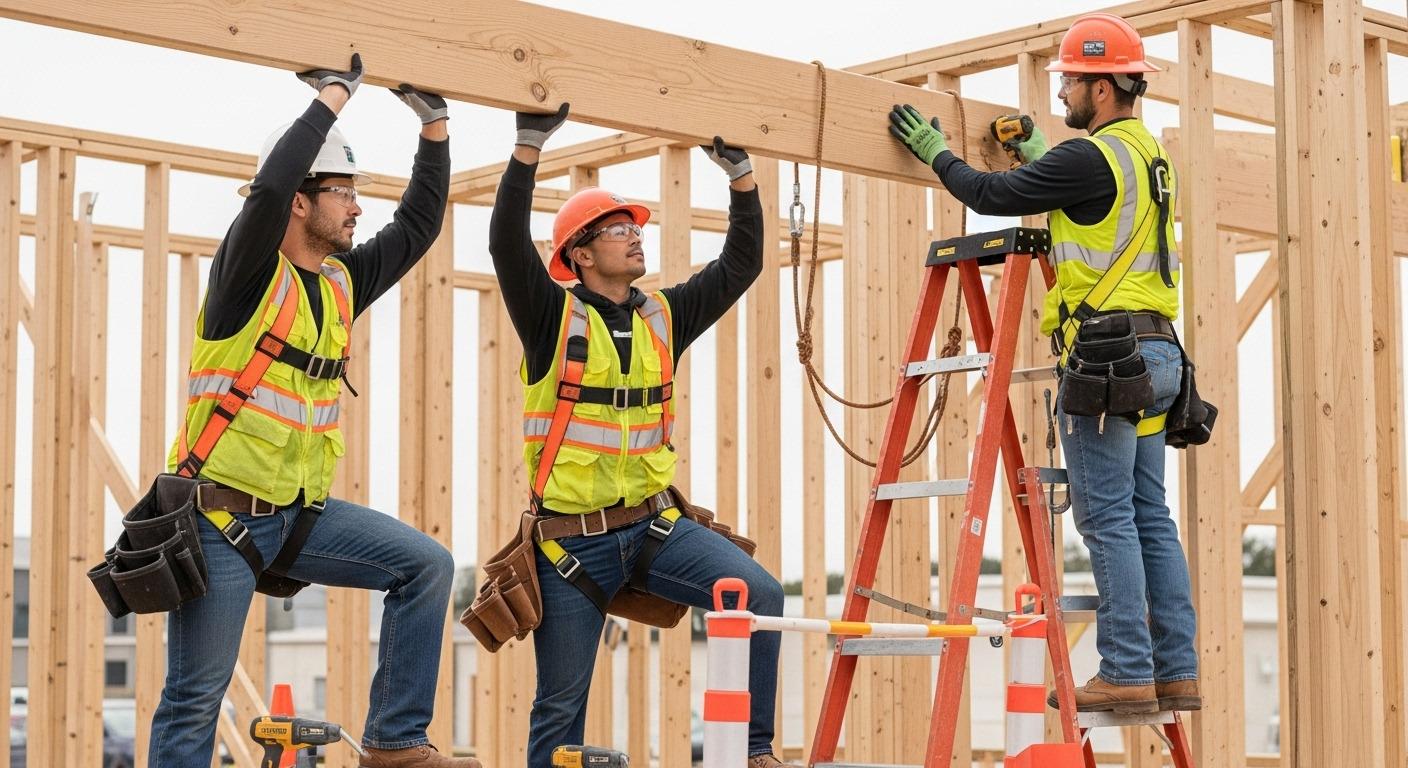How to Frame a House

Framing a house is the process of constructing the structural skeleton that forms the shape and the load-bearing system for the walls, floors, and roofs. It also means joining together the pieces of lumber and the fasteners following a plan so that every system, from the insulation to the electrical, can be installed properly.
What is House Framing
House framing is the phase in the building of a residential property when the framework of the house, its walls, floors, and roof is constructed with wooden or metal studs. This is what gives a home its shape and structural strength.
Importance of Framing in Residential Construction
Without correct framing, the rest of the building process becomes unreliable. All other trades plumbing, HVAC, electrical depend on the framing being right. Mistakes at this stage of work can lead to uneven floors, bowing walls, and windows or doors that are not properly aligned.
At the initial stages, construction workers rely on framing takeoffs to figure out the exact quantity and kind of framing materials required. These comprehensive material lists are indispensable for cost estimation, reduction of waste, and ensuring that schedules are followed. When done correctly, a takeoff can prevent expensive delays caused by insufficient or excess materials.
Planning the Framing Process
Reviewing House Plans and Blueprints
Before constructing anything, architects have to have the building plans of the structure in their hands. The plans indicate the size, height, span, and distance of the structural members, such as floor joists, wall studs, and roof rafters.
Understanding Load-Bearing Structures
An important aspect of the plan is recognizing which walls and parts will be used for the weight of the object above. Load-bearing walls cannot just be on the top of the footings and support beams, they must be utilized for maximum stability.
Securing Permits and Meeting Code Requirements
Building codes in the local area establish the proper ways of building framing, especially as regards the areas of wind and seismic. The work can only start after the permits are obtained to prove compliance as well as allow for inspections.
Tools and Materials Needed for Framing

Essential Hand and Power Tools
|
Tool |
Use |
|
Hammer/Nail Gun |
Driving nails or fasteners |
|
Circular Saw |
Cutting lumber to size |
|
Speed Square/Level |
Ensuring accurate angles and straightness |
|
Chalk Line |
Marking layout lines |
Lumber Types and Grades
Framing is mostly done from dimensional lumber, e.g., 2x4s or 2x6s, of the construction grade. For load-bearing parts, stronger wood such as Douglas Fir or Southern Yellow Pine is usually chosen.
Fasteners, Connectors, and Adhesives
Nails, screws, and galvanized hardware like joist hangers or hurricane ties are the most common fasteners. Construction adhesive is also suitable for floor and roof sheathing.
Site Preparation Before Framing
Clearing and Leveling the Building Site
The place must be totally clear of rubbish and plants. Only a levelled platform can ensure the proper alignment of foundation and framing components.
Marking the Layout with String Lines and Batter Boards
Batter boards are installed and string lines are run in order to mark wall locations and make the work definitely square before any wood is cut or placed.
Laying the Sill Plates
Anchoring to the Foundation
The sill plate, generally made of pressure-treated wood, is fastened to the foundation with bolts that are set in the concrete. This not only connects the concrete foundation to the frame but also creates the first horizontal member on which the rest of the frame will be installed.
Pressure-Treated Wood for Moisture Resistance
The surface of the sill plate is directly exposed to moisture and therefore it is quite susceptible to corrosion. Thus, pressure-treated wood is a must by the local regulations for the application if we want to achieve the maximum durability.
Constructing the Floor Framing
Installing Floor Joists
Joists are laid out at regular intervals and fastened down to the sill plate via hangers or ledgers. Their dimensions and spacing are dictated by the length of the span to be covered.
Subfloor Installation and Sheathing
To build walls that are accurate, builders commonly construct them flat on the floor. Among others, this covers cutting the studs to the necessary length and fixing them between the top and bottom plates by nailing.
Stud Spacing and Headers
The most common spacing is 16 or 24 inches from center to center. Loading is diverted from the opening to the rest of the structure through headers which are set over the doors and windows.
Raising and Securing Walls
The walls are carried to the place and fixed for a short while after they are constructed. Then, they are nailed to the subfloor and joined together at the corners.
Framing Openings for Doors and Windows
Using King and Jack Studs
Framing of openings is done with king studs (full-height) and jack studs (shorter studs that support the headers). This provides strength around the structural gaps.
Adding Headers for Load Distribution
Beams carry the weight of the space over the windows and doors to the uprights on each side, thus they distribute the load evenly throughout the frame and allow the frame to maintain its solidity.
Constructing the Second Floor (If Applicable)
Joist Layout and Blocking
In the same way as the first floor, the second-story floor joists are positioned and the blocking is done to avoid them from twisting and changing their place.
Subfloor Installation Techniques
Subfloor panels are glued in a staggered manner and then nailed, thus the glue will increase the strength and the absence of noises will allow smooth walking.
Framing the Roof Structure
Types of Roofs (Gable, Hip, Shed)
Every roof style has its own different framing approach. Gable roofs are the easiest. In contrast, hip and shed roofs need angled cuts and the support devices become customized.
Installing Rafters or Trusses
Rafters are made one by one and then installed while the trusses are pre-fabricated and have to be placed in the right spot by lifting them up.
Ridge Beam and Collar Ties
A ridge beam is a structure that runs the length of the roof at its highest point and carries the rafters. Collar ties act as a barrier against the spreading of the roof caused by the load.
Sheathing the Exterior Walls and Roof

Wall Sheathing Materials (OSB, Plywood)
Wall sheathing not only creates a strong frame but also serves as a weatherproofing base. OSB is a more economical option, while plywood is superior in durability.
Roof Decking and Weatherproofing
Roof decking is placed in such a way that the wood has room to expand, then an underlayment such as roofing felt is added as a water barrier.
Installing Temporary Bracing
Preventing Shifting During Construction
Diagonal bracing is the technique that allows the walls to remain plumb and square during the process of construction, especially before the roof sheathing is installed which assures that the entire structure is locked in.
Maintaining Squareness and Alignment
Bracing that is done properly eliminates the notion of cumulative errors and makes tasks such as drywall or cabinet installation later become easier.
Framing Interior Walls
Differentiating Load-Bearing vs Non-Load-Bearing
The interior walls section is the one that might or might not be load-carrying. The load-bearing walls need to be firmly aligned with the structural elements that are below
Utility Chase Walls
These are walls of only a little bit bigger size that are constructed to carry plumbing stacks, ductwork, or electrical conduits.
Building the Staircase Framing
Figuring Out Rise and Run
The stair layout has been decided in accordance with the local code requirements for step height (rise) and tread depth (run). Safety is very important so making sure of the accuracy is essential.
Setting up Stringers and Treads
Stringers are the supports with notches for stairs, which are cut out of solid wood. After that, treads and risers are installed as the walking surfaces.
Installing Blocking and Fire Stops
The Function of Blocking in Walls and Floors
Blocking not only strengthens the whole construction but also creates attaching points for the installation of elements such as cabinets, railings, or fixtures.
Fire Stop Regulations
The fire stopping is responsible for the flames and smoke from spreading through the wall cavities. The horizontal blocks are distributed in this way at the intervals stated.
Inspecting the Framing Work
Common Framing Inspection Checklist
Inspectors will verify that the walls are even, the connections are tight, and the code is adhered to with the correct stud spacing, headers, and fasteners.
Fixing Mistakes or Displacements
Changes must be carried out if any faults are discovered before insulation or drywall installation.
Getting Ready for Machines
Spaces for Water, Power, and Air Conditioning
According to the regulations, the holes and notches are added in the places where they can make the structural members weaker.
Carrying out the Work of Notching and Drilling
Only a certain amount of wood can be taken from the joists and studs to be able to fit in the utilities.
Concluding Jobs and Getting Close to the Place to Enclose
Coating the House (House Wrap, Vapor Barriers)
Besides framing and sheathing, the house wrap is also installed to be the barrier against any moisture that comes from the outside.
Window and Door Installation Readiness
Framed openings have to be plumb, square, and correctly supported in order to receive windows and doors.
Safety Tips for Framing a House

PPE and Worksite Safety Practices
Standard safety measures include the use of safety glasses, gloves, hard hats, and harnesses. Power tools should be used with caution.
Safe Lifting and Ladder Use
Never forget to lift with your legs and not with your back, and also, be sure that the ladder is stable before going up.
FAQs About Framing a House
1. How long does it take to frame a house?
Framing typically takes 1-3 weeks, depending on house size, complexity, and crew size.
2. Can I frame my house myself?
Yes, but it requires strong carpentry skills, tools, and knowledge of building codes.
3. What’s included in Takeoffs?
Takeoffs include a detailed count of all framing lumber, connectors, fasteners, and sheathing materials needed for the job.
4. What type of wood is best for framing?
Douglas Fir and Southern Yellow Pine are commonly used for their strength and availability.
5. Do I need a permit to frame a house?
Yes, permits are usually required before framing begins, and inspections are mandatory.
- AI
- Vitamins
- Health
- Admin/office jobs
- News
- Art
- Causes
- Crafts
- Dance
- Drinks
- Film
- Fitness
- Food
- Games
- Gardening
- Health
- Home
- Literature
- Music
- Networking
- Other
- Party
- Religion
- Shopping
- Sports
- Theater
- Wellness


